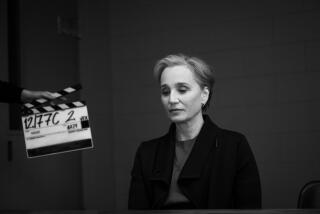COMMENTARY : Can a Meanie Make It in Sitcomland? : Television: ‘The Jackie Thomas Show,’ with Tom Arnold, is trying to beat the odds by having a thoroughly distasteful protagonist.
ABC’s new series, “The Jackie Thomas Show,” raises an intriguing question about American TV and its audience: Is it possible to build a successful situation comedy series around a character who is thoroughly distasteful?
The emphasis here is on the word thoroughly . There is a rather strong tradition on U.S. television (and radio and movies before that) of mounting sitcoms with central protagonists who blend an outrageously unlikable side with a persuasive charm.
Instantly recognizable cases in point are Jackie Gleason’s explosive Ralph Kramden in “The Honeymooners,” Sherman Hemsley’s scheming George Jefferson in “The Jeffersons,” Ted Knight’s Ted Baxter in “The Mary Tyler Moore Show,” Ted Danson’s monomaniacally libidinous Sam Malone in “Cheers” and Candice Bergen’s peevishly dismissive Murphy Brown.
These people often act obnoxiously, but they have endearing sides, too. Those more acceptable facets are brought out in their interactions with continuing characters, whose function it often is to eke lovability out of hopelessly disagreeable facades. That is one explanation for Murphy Brown’s baby.
The progenitor for the irredeemably mean TV sitcom star was Carroll O’Connor’s Archie Bunker on “All in the Family.” That twist on the family comedy formula blended Ralph Kramden’s short fuse with the bad-mouth bigotry of a Klansman. When it appeared in 1971, newspapers and other journals of opinion carried loud debates about the advisability, even the morality, of having such an individual appear weekly on the home tube.
Ignored in the passage of time, though, is the fact that the character who inspired that concern died fairly quickly in the life of that decade-running series. Over time, Archie’s character softened tremendously, his racism toned down and humanity brought out through his wife, Edith. By the time the character left prime time (in “Archie Bunker’s Place”), he had become a symbol not of racism but of a reluctantly changing Middle America, a man with a Jewish business partner and an adopted Jewish daughter.
In fact, while somewhat unlikable central characters are a staple on television, changes in the sitcom formula to make one of the key players an out-and-out misanthrope have been rare and short-lived. The attempts came during the 1980s, when the networks began to entertain previously unacceptable program suggestions to attract that part of their audience fleeing to cable and video.
NBC took the chance with “Buffalo Bill,” with Dabney Coleman perfectly cast as a nasty-mouthed talk-show host. The program drew critical acclaim for its fresh humor in a stale comic landscape but couldn’t sustain acceptable ratings. ABC tried “The ‘Slap’ Maxwell Story,” another Dabney Coleman vehicle, and “Good and Evil,” dark humor involving a wonderful woman and her hurtful sister. They, too, crashed.
The Fox network also got into the obnoxious character hunt. Fox has generally been a bit more adventurous than ABC, CBS and NBC in trying to subvert the traditional sitcom--partly as a way to gain attention, partly as a device for luring young audiences and partly because Fox’s criteria for ratings success are lower than those of the Big Three. Still, of the comedy offerings on Fox, only “Married . . . With Children” can be said to have been successful presenting thoroughly dislikable central characters on a weekly basis. And unlike Buffalo Bill and Slap Maxwell, “Married’s” Bundy family are so cartoon-like in their outrageousness to one another as to be clearly a takeoff on the sitcom formula, not a true addition to it.
Fox did try its own Dabney Coleman sitcom--about a bad-mouthing white-collar criminal who is forced to teach schoolchildren--but that series (“Drexell’s Class”) flopped as quickly as his other two.
All of which would suggest that the networks, playing the odds, would not likely try to build another situation comedy around a thoroughly dislikable character. What is fascinating about “The Jackie Thomas Show” is that it seems to be tilting against those odds--and doing it quite consciously, even enthusiastically.
The show is the offspring of Roseanne and Tom Arnold, two of the most powerful people in television today (which may explain how it got off the ground in the first place and surely explains its plum spot on the schedule--after the hit “Roseanne”).
The title character, Jackie Thomas, is an actor in his own situation comedy. As played by Tom Arnold, he is loud, self-centered and mean, with a violent streak. In the first episode, he jealously tried to fire the boy who plays his adolescent son in his series by killing him off in the show. His reason: The likable young man has begun to get a lot of attention from the press and the public.
The Thomas character is as hateful as the other characters whose shows flopped. The difference here is that the Arnolds have craftily placed their obnoxious star into the mold of one of the most beloved of television series, “The Dick Van Dyke Show” of the 1960s. From the start of the first episode, when Van Dyke’s photo is shown on the head writer’s desk, the creators make it clear that they see “The Jackie Thomas Show” as “The Dick Van Dyke Show” transplanted to the ‘90s.
Just as that classic ‘60s sitcom was about a group of writers crafting a program for a loutish star, so “The Jackie Thomas Show” has a group of writers crafting a program for a loutish star. The roles of Rose Marie, Morey Amsterdam and Richard Deacon are taken, roughly, by Maryedith Burrell, Michael Boatman and Martin Mull. The scenes in which the writers talk snidely about boss Thomas echo the scenes in which Van Dyke and company had to write jokes for their joke of a star, Carl Reiner’s Alan Brady.
This is where the new program takes its risky turn, though. In the Van Dyke series, Brady was off-camera most of the time. During the first couple of years, in fact, the character was heard through an intercom and not even seen. That move allowed Brady to function primarily as the butt of intermittent jokes without souring the essentially homey on-camera action. Plots centered generally on the writers and Van Dyke’s idyllic television family.
“Jackie Thomas,” by contrast, moves the Brady character to center stage. The Van Dyke surrogates are craftily positioned to draw out the viewer’s sympathy and to make the viewer care about them in ways that previous series about obnoxious people do not. Yet the title of the show, along with the fact that Arnold the creator plays Thomas, suggests quite clearly that they will take a back seat to the star.
The history of such persona on network television suggests that the chances of “Jackie Thomas” surviving are slim. Shows like “Barney Miller,” “Cheers,” “Taxi”--and “Jackie Thomas”--remind us that all situation comedies are essentially family situation comedies, since in those programs the work group takes the role of the family. Viewers may well find it jarring to confront every week the thought that a laugh-tracked, domestic side of life could support the kinds of meanness, darkness and air of violence that they associate with urban dramas such as “L.A. Law,” “Law & Order” and “Civil Wars.”
In American Life, the distance between “Civil Wars” and “The Dick Van Dyke Show” may be close, getting closer all the time. In the American Psyche, represented by prime-time TV, the separation of these two worlds has been a fundamental fact of life. It remains to be seen if, by wrapping a subversive character in a sitcom classic, Roseanne and Tom Arnold can change that.
More to Read
The complete guide to home viewing
Get Screen Gab for everything about the TV shows and streaming movies everyone’s talking about.
You may occasionally receive promotional content from the Los Angeles Times.






